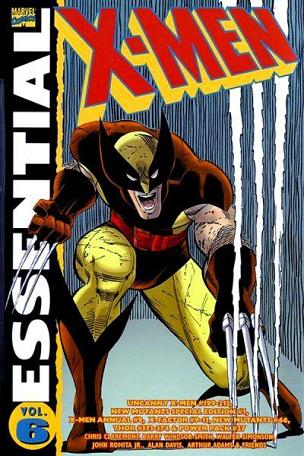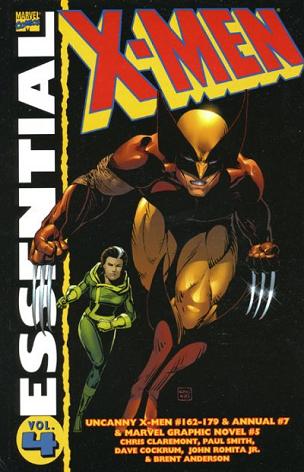
Essential X-Men Vol. 06
Chris Claremont, John Romita Jr., Arthur Adams and friends
Reprints: X-Men #199-213 and more (July 1970 – December 1972)
Get this for: X-Men fighting losing battles — four stars
And so we reach Late Period Claremont with Volume six of Essential X-Men, having of necessity skipped Vol. 5 — such is the danger of buying from a remainders shop. This is my least favourite period of Claremont’s X-Men even though this was also when I bought my first issues new off the rack, in Dutch translation, with #200 being my first one. Didn’t start to regularly buy the series until much later though; limited pocket money led me chose The Avengers and Spider-Man over The X-Men. At least they won their fights more often than not.
Because Late Period Claremont is a very depressing writer and the world he lets the X-Men operate in here is dark and bleak, where the villains have become much more dangerous and murderous, friends have all vanished and everything the X-Men do goes wrong. From the start of his run on X-Men Claremont had a tendency to make the X-Men’s battles ambiguous and them suffer, as well as a prediliction for long running and complicated subplots, with various threats kept simmering on the backburner for long stretches. In the current volume this has reached the point where it seems the X-Men are destined never to win another battle, or vanquish a foe. Meanwhile subplots over the course of the series have taken longer and longer to resolve and here they seemingly never do so…
So the volume starts with the inconclusive trail of Magneto in Paris in #199-200, for which the entire creative team actually got to fly to Paris for, as a reward for their succes with the X-Men. The trail is interrupted by a crossover with the New Mutants in Asgard, itself a followup to an earlier X-Men/Alpha Flight adventure. The trial ends inconclusive, professor Xavier has a health crisis and is taken into space by the Starjammers, while veteran X-Man Cyclops leaves next issue, after losing a leadership battle to the now powerless Storm. The next couple of issues has them tangling with the Beyonder, as Secret Wars II comes to visit. Two solo adventures of Nightcrawler and Wolverine, the latter being almost killed by some old enemies lead us into a confrontation with the socalled Freedom Force, the Brotherhood of Evil Mutants under a new name and sanctioned by the US government.
After that Rachel Summers, the daughter of Scott “Cyclops” Summers and Jean “Phoenix” Grey from the “Days of Future Passed” alternate future, decides to take on the Hellfire Club on her own, to take her revenge on the psychic vampire and mass murdereress Selene, only to be almost killed herself by Wolverine as the only way to stop Rachel from becoming a murderer herself. This of course leads to a fullblown battle between the Hellfire Club and the rest of the X-Men, which in turn is interrupted by the attack of Nimrod, the ultimate Sentinel mutant hunter, which forces the two teams to work together to defeat him, barely. All of which is merely a prelude to the Mutant Massacre, the first proper mutant mega crossover, between the X-Men, New Mutants, Power Pack, Thor and X-Factor, the culmination of several years of subplots about the general public’s growing paranoia and hatred of mutants.
The crossover revolves around a new group of villains, the Marauders, largely new but with some old faces thrown in, who go on a killing spree against the Morlocks, mutant outcasts living in an old, abandoned fallout shelter underneath New York. Most of them have barely any powers and are easy prey for these killers, who strike without motive. Why the Marauders strike is never explained and the most the X-Men or any of the other heroes involved can do is damage control. The Mutant Massacre is everything The X-Men has been building towards for years: intense frustration.
Frustration, because Claremont keeps on twisting the knife. Throughout this volume the X-Men keep losing battles, keep getting wounded and nearly killed, keep failing to protect themselves and others from increasingly murderous villains. The Mutant Massacre is just the icing on the cake. Claremont is good at piling up the pressure month to month, but reading this in one sitting the frustration just gets too much. It’s the Joker problem as much as anything: if the Joker is killing people indiscriminately every time he breaks out of Arkham Asylum, Batman looks like a smuck rather than a hero if he doesn’t kill him in battle but delivers him back to Arkham to escape again. With the X-Men, you have them facing menaces able and willing to kill every mutie in the country, yet they’re still playing by superhero rules, not wanting to kill a mass murderer like Selene. What’s even worse about that issue is that Wolverine himself way back in #116 had been shown (offpanel) to kill a guard in the way when the X-Men were trying to sneak into a villain’s headquarters.
What also frustrated me was the theme of mutant paranoia. It was always present in the series of course, but here it completely dominates The X-Men. At times it seems every human, including superheroes like The Avengers or the Fantastic Four hates and fears the X-Men, no matter what they do. It feels manipulative at times.
Which brings me to that other mutant series, X-Factor, which has some of its issues collected here in the Mutant Massacre crossover. The creation of X-Factor, done largely without Claremont’s input, was a mistake, not in the least because it led to the cancellation of one of my favourite series, Defenders. The idea behind the series was ridiculous — the original X-Men regrouping and posing as the mutant hunters X-Factor, to find and train dangerous new mutants — and the fallout of it poisoned the X-Men for years, with the worst consequence being the whole “return of Jean Grey/Scott Summers leaving his bride Madelyne Pryor plus newborn baby” business.
All of which amounts to a lot of silent screaming at the comic, as my frustration gets the better of me. To be honest, this frustation is not all bad: Claremont must be doing something right to get thousands of fans buying the series month in month out despite it or perhaps because of it. He certainly kept me reading. It helps a lot to have John Romita Jr. doing the art: his dark, scratchy style fits the series well.
